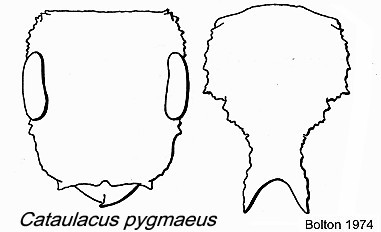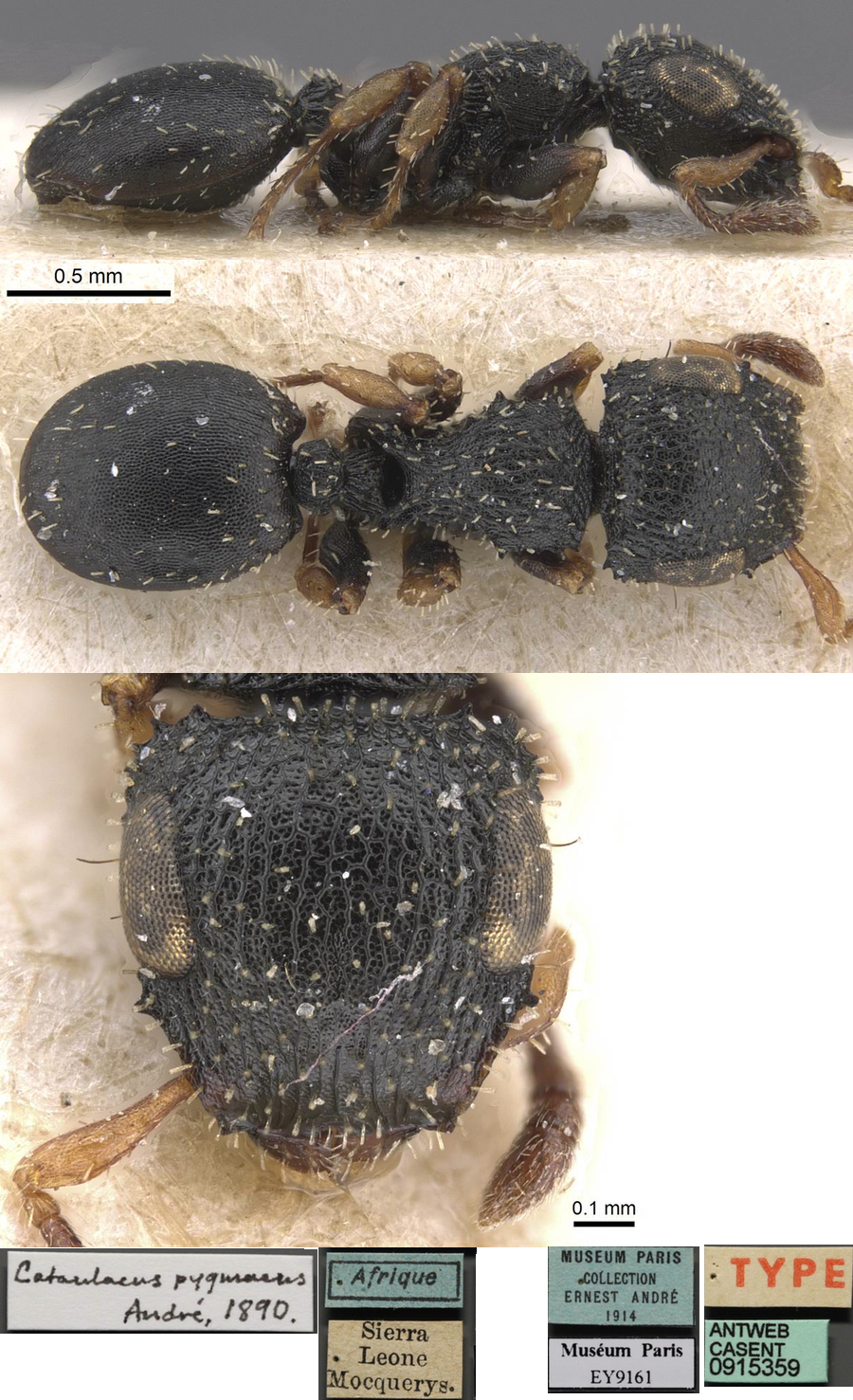Cataulacus pygmaeus André
  Type location Sierra Leone
(André, 1890: 325, worker), collected at 'Riv.N' Gamie, Chutes de
Samlia, A. Mocquerys - see below Type location Sierra Leone
(André, 1890: 325, worker), collected at 'Riv.N' Gamie, Chutes de
Samlia, A. Mocquerys - see below
junior synonyms
bakusuensis (Cataulacus
pygmaeus André v. bausuensis
n. v., Forel,
1913h: 350, queen & male) from Zaïre, at Bakusu - see
(queen) http://www.antweb.org/specimenImages.do?code=rmcaent000017797
chariensis
(Cataulacus pygmaeus André
var. chariensis nov.,
Santschi, 1911c: 358, worker) from Chad, collected at Moyen
Chari, Fort-Archambault, by Dr J Decorse, 1904 (Bolton, 1974a and
1995) - no images on Antweb (September 2014)
all forms known  . .
|
 André's
(1890) description is at André's
(1890) description is at  and Santschi's (1911c)
description of chariensis
is at and Santschi's (1911c)
description of chariensis
is at  . Forel's (1913h)
description of bakusuensis is at . Forel's (1913h)
description of bakusuensis is at  . Bolton's modern description (1974a) is at . Bolton's modern description (1974a) is at

WORKER - TL 3.7-4.4 mm; the distinguishing feature of
the stout hairs which expand from base to apex was described as rare
for the "species" by Bolton (1974a: 48, illustrated full-face view and
dorsal alitrunk), when he had the now-revived (by Bolton, 1982: 359) Cataulacus
traegaordhi as a junior synonym.
Otherwise, Bolton (1982) lists it from Ghana and
Cameroun.
|
 Nigeria
specimens (Taylor, 1979: 15, as Cataulacus weissi). WORKER. TL 3.3-3.6 mm, HL 0.82-0.96, HW
0.74-0.86, SL 0.40-0.50, PW 0.60-0.70 Nigeria
specimens (Taylor, 1979: 15, as Cataulacus weissi). WORKER. TL 3.3-3.6 mm, HL 0.82-0.96, HW
0.74-0.86, SL 0.40-0.50, PW 0.60-0.70
Occipital corners and remainder of head behind the eyes only
denticulate. Dorsum of head and alitrunk with fine loose rugoreticulum.
Simple blunt hairs numerous all over. Alitrunk marginate laterally with
the margins denticulate. Propodeal spines short and acute. Subpetiolar
process complex with the posteroventral angle a long heel or spur.
Subpostpetiolar process digitiform.
From low vegetation at the Cocoa Research
Institute of Nigeria, Idi Ayunre, Block W22.
Prior to sighting the type images (September 2014) I had thought this specimen was Cataulcaus weissi but it matches almost exactly the type (below).
|
 The photomontage of the type worker is collated from http://www.antweb.org/specimen.do?name=casent0915359 The photomontage of the type worker is collated from http://www.antweb.org/specimen.do?name=casent0915359
|
Oxford University Museum
specimens
Cataulacus pygmaeus
B Taylor det.
|
Gabon
Y Braet
Gabon 109
|
7-8.viii.2006
Pongara
00°34' N
09°19' E
|
Sesame & forest,
sweep net
|
1
|
 |
|
 The
photomontage is of a worker from Gabon, Pongara National
Park; Gabon 109; 1-8.viii.2006; sweep net, sesame & forest;
collected by Yves Braet. The
photomontage is of a worker from Gabon, Pongara National
Park; Gabon 109; 1-8.viii.2006; sweep net, sesame & forest;
collected by Yves Braet.
I suspect that this may be a savannah species, while traegaordhi
is a forest species but it may be that the taxonomic position still is
not satisfactory. Thus, it may well be among the findings from Mt.
Nimba, Guinea, which came from both savanna and forest
locations, being numerous at the savanna sites (Kéoulenta and Ziéla),
and living in stems (twigs?) and under bark (Bernard, 1952). The new Gabon
findings of both from essentially the same area suggest a species
overlap.
|
|